Abstract
Thermal stability of different types of metallic glasses and partially crystalline alloys stored for at least 15 years at ambient conditions was tested in the present work by differential scanning calorimetry in comparison with that of the original alloys tested in the as-cast state in the earlier works. The structure of the naturally aged alloys was also studied by X-ray diffractometry. The structure of a couple of selected alloys was also tested by transmission electron microscopy. Most of the alloys retained their initial structure and showed only a moderate decrease in the crystallization temperature. Only those alloys which showed visible surface oxidation (Cu-Zr-system based) were partly transformed into a crystalline state forming micron-scale Cu particles in air at ambient conditions.
1. Introduction
Glassy alloys/metallic glasses [1] as well as bulk (volumetric) metallic glasses (BMGs) [2,3] are metastable at room temperature and crystallize on heating above the temperature (Tx) which, as well as the glass-transition temperature (Tg) (measured as an inverse glass-transition from a glassy state to a supercooled liquid one on heating) depends on the heating rate used [4,5]. Some of glassy alloys (usually called amorphous alloys) crystallize directly on heating [6] while others upon fast enough heating initially transform to a supercooled liquid which crystallizes at a higher temperature. In some alloys such a transition drastically affects the crystallization reaction which changes from an eutectic one below Tg to a primary one above it [7]. The glassy alloys with a low Tx crystallize even at room temperature [8,9] but for the majority of glassy alloys the process is very slow [10,11].
The time-temperature-transformation (TTT) diagrams created in the isothermal mode (or under continuous heating) are useful for comparison of the thermal stabilities of different glasses against devitrification and for selection of the heat treatment regimes. Such diagrams have been created for various metallic glasses, for example, Zr- [12], Au- [13] and Pd-based [14,15]. Comparison of the long-term thermal stabilities of different metallic glasses was also performed using continuous heating transformation (CHT) diagrams [16]. Early transition metals: Ti-, Zr- and Hf-based metallic glasses were found to have a similar time-temperature gradient of the curves related to the beginning of crystallization independently from those initial devitrification products (crystal or quasicrystal) and transformation mechanism. Metalloid-rich Si- and Ge-based glasses exhibited quite high long-term thermal stability. Late transition metals: Cu- and Ni-based metallic glasses showed high thermal stability at a short time scale. CHT diagrams were also recalculated from the isothermal TTT ones [17] using a method similar to that used in Reference [18]. These calculations predict lifetime temporal stability of metallic glasses at room temperature if those Tx values are at least ~200 K above that [19] and no other factors except for temperature are taken into account. In the past thermal stability of metallic glasses was usually tested on heating. In the present work we test long-term thermal, and partly chemical stability, of different metallic glasses at ambient conditions.
2. Experimental Procedure
Ingots of the studied alloys were prepared by arc-melting the mixtures of pure elements > 99.9 mass% purity in an argon atmosphere (99.9995%) while the ingots of Mg-based alloys were produced by induction melting. From these alloys, ribbon samples of about 0.02 mm in thickness and 1.0 mm in width were prepared by rapid solidification of the melt on a single copper roller at the wheel surface velocity of 42 m/s. All samples were stored in air placed in a zipped plastic box to avoid drastic contamination with organic dust for at least 16 years at ambient conditions.
The phase composition of the glassy ribbon samples was studied by conventional X-ray diffractometry (XRD) using D8 Advance Diffractometer (Bruker Co., Karlsruhe, Germany) with a monochromatic CuKα radiation. The thermal stability was tested by differential scanning calorimetry (DSC) using Seiko Exstar SII 6300 calorimeter (Seiko Instruments & Electronics Ltd., Tokyo, Japan) heat-flux type machines at a heating rate of 0.67 K/s in a high-purity Ar atmosphere containing more than 99.9995% of Ar. The calorimeter was calibrated using pure Sn in the low temperature range and using Al in the high temperature one. Each sample was measured twice up to complete crystallization. The data of the second run were used as a baseline for each measurement.
Transmission electron microscopy (TEM) investigations of two selected samples were carried out using a JEM 2010F microscope (JEOL Co. Ltd., Tokyo, Japan) operating at 200 kV. Bright-field, dark-field, and high-resolution TEM (HRTEM) images, as well as selected area electron (SAED) and nanobeam diffraction (NBD) patterns were obtained. The microstructure of the naturally oxidized samples was examined by a HITACHI S-4800 scanning electron microscope (SEM) (Hitachi Co. Ltd., Tokyo, Japan) carried out at 15 kV equipped with an energy dispersive X-ray (EDX) spectrometer.
3. Results
Table 1 shows chemical compositions of the studied alloys, the literature reference number, the number of years passed after preparation, the temperatures obtained by DSC, and the calculated temperature differences such as ΔTg = Tgi − Tga, ΔTx = Txi − Txa and ΔTrx =ΔTx/Txi as indicated in the table. The original (initial) DSC traces were obtained earlier [20,21,22,23,24,25,26,27,28,29]. A few selected DSC traces (both of initial and aged samples) are shown in Figure 1a. As one can see, although the crystallization temperature (Tx) is slightly reduced after more than 15 years of aging the reduction is only a few Kelvin even for the alloys with rather low Tx. It is in line with high room temperature thermal stability of metallic glasses predicted by the extrapolation of the high-temperature part of CHT and TTT diagrams [16,19].

Table 1.
Chemical compositions of the studied alloys in the as-prepared state (marked as initial) and after room-temperature aging for some time (marked as aged), the reference number (Ref), the number of years passed after preparation (NY) and the related temperatures as well as temperature differences absolute (ΔTg and ΔTx), and relative (ΔTrx).
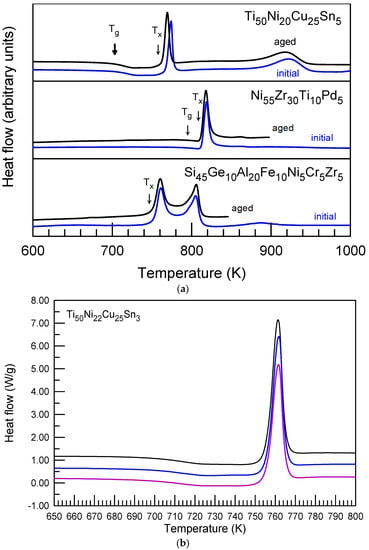
Figure 1.
(a) DSC traces of some glasses and a partly crystalline material as indicated in the initial (as-cast) and naturally aged state. (b) A series of independent measurements for the Ti50Ni22Cu25Sn3 alloy after the aging at room temperature for 20 years as indicated in Table 1.
The glass-transition temperature (Tg) as a result of room-temperature aging is either decreased or increased even in the case of similar alloys. For example, see the ΔTg values for the Cu55Zr30Ti10Au5 and Cu55Zr30Ti10Pd5, as well as Ni55Zr30Ti10Pd5 and Ni55Zr30Ti10Pt5 alloys, respectively, (Table 1) which exhibited the opposite changes in Tg. It is likely connected with the baseline instability close to Tg owing to heat release during structural relaxation.
Three independent measurements were performed for the naturally aged Ti50Ni22Cu25Sn3 alloy and the resulted DSC curves are shown in Figure 2b. Tx defined by the intersection of two tangents to the curve before and after the inflection point for each measurement is 754 K which leads to the standard error value below 1 K. Tg values of 695, 697, and 700 K lead to the average value of 697 K with much larger uncertainty compared to Tx. The standard error is ±1.5 K while if the Student’s criterion is taken into account owing to small number of measurements (low degree of freedom) then the confidence interval (C.I.) is ±3.4 K. Thus, the heat release during structural relaxation shields glass transition, which makes measurement of Tg much less accurate.
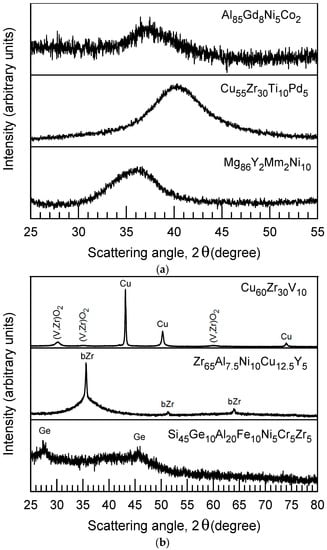
Figure 2.
XRD patterns of the glassy (a) and partly crystalline alloys (b) after room-temperature aging as indicated in Table 1. bZr denotes beta Zr solid solution.
The Al85Ni5Co2Y6Pd2 alloy having amorphous + nanoscale Al structure is also quite stable against the room-temperature aging (even though Al-based glass-forming liquids are very fragile [30]) as well as the Si45Al20Fe10Ge10Ni5Gr5Zr5 one containing nanoscale precipitates of a solid solution of Si in cF8 Ge. The nanoparticles also exhibit high stability at room temperature. ΔTrx for all alloys studied, except for those affected by corrosion (see the notes below Table 1), is less than 1%.
The X-ray diffraction patterns of typical alloys are shown in Figure 2. Most of the studied alloys retained those initial glassy (Figure 2a) or partly crystalline (Figure 2b) structure as well as the original silver metallic color. The diffraction patterns of partially crystalline samples also correspond to those of the as-cast samples studied earlier. No visible changes in the X-ray diffraction patterns are found. Transmission electron microscopy observation also confirmed preservation of the glassy structure even in an alloy with rather low crystallization temperature (Figure 3a) and in a partly crystalline one (Figure 3b). No traces of crystallinity are seen within the glassy area even when studied using nanobeam diffraction with the probe size of 1 nm.
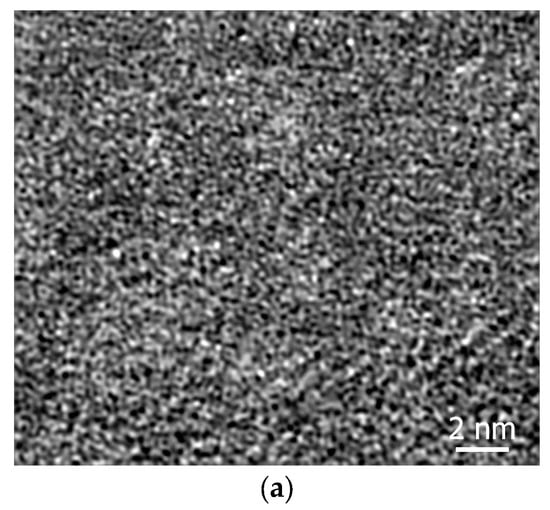
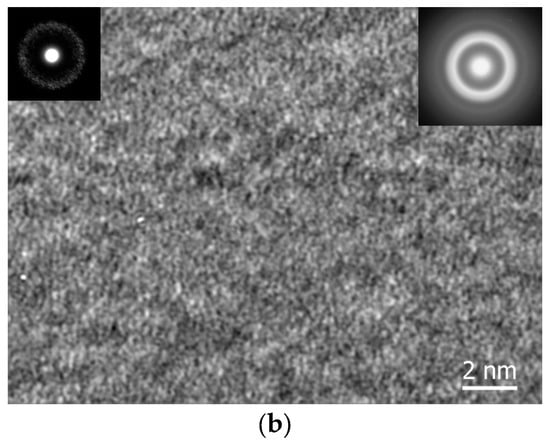
Figure 3.
HRTEM images of (a) the Al85Gd8Ni5Co2 glassy alloy and (b) of the glassy area in the Zr65Al7.5Ni10Cu12.5Y5 alloy naturally aged for 17 years. The inserts in (a) are typical nanobeam diffraction (NBD) and selected area electron (SAED) patterns (left and right side, respectively).
Cu-based alloys are not oxidized if they contain at least Ti. It is connected with good protective properties of the surface films containing both Ti and Zr oxides [31,32]. However, the binary Zr50Cu50 (Figure 4) and ternary Cu60Zr30V10 (Figure 2b) alloys are severely oxidized. The Cu60Zr30V10 ribbon samples are deeply oxidized forming a nanocrystalline tetragonal (Z,V)O2 oxide and demonstrate brown color on both sides. The surface layer consisting of Cu and the oxide is so deep that no signal from the amorphous phase was detected. The initial exothermic reaction likely related to the growth of pre-existing Cu crystals started at 438 K instead of 790 K shown in Table 1 for the as-cast alloy. The second peak related to crystallization of the glassy matrix below the oxide phase started at 778 K, which is 12 K lower than that for the initial as-prepared sample.

Figure 4.
XRD patterns of the Zr50Cu50 sample naturally aged for 17 years. Brown (upper one)—from brown side, black (lower one )—from silver side of the ribbon.
The Zr50Cu50 sample was prepared and initially studied in 2002 while the results were published in 2007 together with these for the Zr-Cu-Al alloys [29]. The Zr50Cu50 metallic glassy ribbon samples have two sides of different color. Free side which was in contact with air on rapid solidification is dark silver metallic while the side which was in contact with a copper wheel and has a rougher surface is brown. However, in this alloy the oxide layer is thinner than in the Cu60Zr30V10 sample and a strong enough broad peak from the amorphous phase is obtained between 32 and 45 degrees of 2 theta (Figure 4).
Here, as well as in the case of the Cu60Zr30V10 alloy, nanocrystalline oxides (orthorhombic ZrO2 and tetragonal Cu4O3 one) are formed while Cu crystallized on the surface (see Figure 4). Larger, micrometer-scale particles are formed on the rough ribbon surface, which was in contact with Cu wheel though Cu oxide, is also formed. The Zr50Cu50 sample was studied by SEM on both sides (Figure 5). Rough micron-scale crystals are seen on the brown surface while the dark silver metallic surface was smooth. EDX spectral analysis showed that the micron-scale particles are Cu crystals (Table 2).
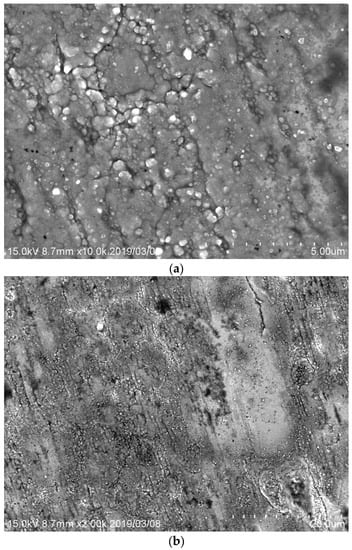
Figure 5.
SEM images of the Zr50Cu50 sample naturally aged for 17 years. (a) Brown side and (b) silver side.

Table 2.
Chemical composition in at% of both sizes of the Zr50Cu50 glassy ribbon naturally aged for 17 years, SEM, EDX.
4. Discussion
Most of the metallic glasses stored at ambient conditions for more than 15 years studied in the present work retained the original silver metallic color and their initial either glassy or partly crystalline structure. The X-ray diffraction and transmission electron microscopy observations confirmed preservation of the glassy structure. Although the crystallization temperature is slightly reduced after natural aging the reduction is only a few Kelvin (from 1 to 4 K depending on composition (Table 1)) which is negligibly small from the viewpoint of industrial application. It confirms high room-temperature stability of metallic glasses suggested in the earlier works [17,19]. The reduction of the crystallization temperature is likely connected with natural structural relaxation of the glassy phase, a minor surface oxidation and contamination with the organic substances, which can enhance surface induced crystallization by activating heterogeneous nucleation [33].
Precipitation of micron-scale Cu crystals at room temperature found in some Cu-rich glasses requires long-range diffusion. It was reported [34] that although oxidation of the Zr50Cu50 alloy on heating at 500–700 °C starts from preferential oxidation of zirconium copper forms Cu51Zr14 phase at the metal/oxide interface. Cu-enriched layer was also found to form at the metal/oxide interface in subsequent research works [35,36]. Moreover, the alloy did not oxidize noticeably below 400 °C. Nevertheless, oxidation on heating takes place in rather dry environment while air humidity alters the oxidation mechanism at room temperature leading to electrochemical corrosion, and thus, enhanced surface diffusivity of Cu.
Crystallization [37,38] and electrochemical corrosion [39,40] of the Zr50Cu50 glassy alloy were studied extensively. A recent work particularly reflected its complicated crystallization behavior [41]. Higher Cu content causes an increase in the passivation current of Cu-Zr glassy alloys [42]. The competition between oxidation of Zr atoms forming ZrO2 film owing to its high formation enthalpy with oxygen and the oxidation-induced segregation of Cu atoms plays an important role in the electrochemical behavior of the Zr-Cu glassy coatings [43].
According to the Ellingham diagrams [44] there is a large difference in the Gibbs Free Energy change on the formation of zirconium and copper oxides. Even at very low concentrations of zirconium in a copper melt containing oxygen, copper oxide formation is thermodynamically unlikely [45] because Zr acts as a flux. Thus, Cu is repulsed from ZrO2 matrix and clustered as pure Cu. Although nanocrystalline Cu was formed on the surface of Zr70Cu30 metallic glass stored for eight years [33] here we show the formation of microcrystalline Cu at room temperature at ambient conditions.
An open question is why no intermediate Cu-Zr intermetallic compounds are formed on the surface of Zr50Cu50 and Cu60Zr30V10 alloys in accordance with the Cu-Zr phase diagram but pure Cu? Although the glassy phase rather easily forms in the alloys containing as much as 70 at% Cu and more [46] formation of Cu51Zr14 (hP65) phase with high thermal stability as well as Cu9Zr2 (tP24) or Cu8Zr3 (oP44) should be possible [47] at an intermediate state when the glassy phase becomes gradually diluted in Zr. A reasonable explanation is connected with difficulties in bypassing the energy barrier for nucleation of these phases at room temperature.
It is also known that Zr-Cu-based glassy alloys are, in general, predisposed to show clustering of Cu near the surface. For example, a homogeneous Zr-Al amorphous oxide film was formed in several munities on the surface of the Cu47Zr45Al8 metallic glassy alloy while Cu segregated at the metal/oxide interface [48]. The Cu2O nanoparticles were also formed within the Zr-Al amorphous oxide film. Moreover, pure Cu precipitated within the Zr-Cu glassy layers on annealing [49]. Cu-rich layer was also formed on the surface of Zr-Cu-Fe-Al and Zr-Cu-Ni-Al metallic glasses subjected to cryogenic cycling treatment [50].
5. Conclusions
Most of the studied metallic glasses stored at ambient conditions for more than 15 years retained the original silver metallic color and initial either glassy or partly crystalline structure. No visible changes in the X-ray diffraction patterns are found. Transmission electron microscopy observation also confirmed preservation of the glassy structure in two alloys. Although the crystallization temperature is slightly reduced after more than 15 years of natural aging the reduction is only a few Kelvin. The results directly confirm high room-temperature stability of metallic glasses.
The aged Cu-based alloys are not oxidized (only a native thin film is observed) if they contain at least Ti. However, the binary Zr50Cu50 and ternary Cu60Zr30V10 alloys are severely oxidized. Moreover, precipitation of micron-scale Cu crystals was found in both alloys at room temperature as a result of surface oxidation at natural humidity indicating fast surface diffusion.
Author Contributions
Conceptualization, D.V.L.-L. and J.J.; formal analysis, D.V.L.-L.; investigation, D.V.L.-L.; data curation, D.V.L.-L. and J.J.; writing—review and editing, D.V.L.-L. and J.J.
Funding
This research was funded by the World Premier International Research Center Initiative (WPI), MEXT, Japan.
Conflicts of Interest
The authors declare no conflict of interest.
References
- Greer, A.L. New horizons for glass formation and stability. Nat. Mater. 2015, 14, 542–546. [Google Scholar] [CrossRef] [PubMed]
- Suryanarayana, C.; Inoue, A. Bulk Metallic Glasses; CRC Press: Boca Raton, FL, USA, 2011; p. 543. [Google Scholar]
- Louzguine-Luzgin, D.V. Metallic Glasses and Those Composites; Materials Research Forum LLC: Millersville, PA, USA, 2018; p. 336. [Google Scholar]
- Kaloshkin, S.D.; Tomilin, I.A. The crystallization kinetics of amorphous alloys. Thermochim. Acta 1996, 280–281, 303–317. [Google Scholar] [CrossRef]
- Liu, F.; Sommer, F.; Bos, C.; Mittemeijer, E.J. Analysis of solid state phase transformation kinetics: Models and recipes. Int. Mater. Rev. 2007, 52, 193–212. [Google Scholar] [CrossRef]
- Perepezko, J.H. Nucleation-controlled reactions and metastable structures. Prog. Mater Sci. 2004, 49, 263–284. [Google Scholar] [CrossRef]
- Louzguine, D.V.; Inoue, A. Strong influence of supercooled liquid on crystallization of the Al85Ni5Y4Nd4Co2 metallic glass. Appl. Phys. Lett. 2001, 78, 3061–3063. [Google Scholar] [CrossRef]
- Zhang, B.; Zhao, D.Q.; Pan, M.X.; Wang, W.H.; Greer, A.L. Amorphous metallic plastic. Phys. Rev. Lett. 2005, 94, 205502. [Google Scholar] [CrossRef] [PubMed]
- Zhao, K.; Li, J.F.; Zhao, D.Q.; Pan, M.X.; Wang, W.H. Degradable Sr-based bulk metallic glasses. Scr. Mater. 2009, 61, 1091–1094. [Google Scholar] [CrossRef]
- Louzguine-Luzgin, D.V.; Polkin, V.I. Properties of bulk metallic glasses. Russ. J. Non-Ferrous Met. 2017, 58, 80–92. [Google Scholar] [CrossRef]
- Madge, S.V. Toughness of bulk metallic glasses. Metals 2015, 5, 1279–1305. [Google Scholar] [CrossRef]
- Peker, A.; Johnson, W.L. Time-temperature-transformation diagram of a highly processable metallic glass. Mater. Sci. Eng. A 1994, 179–180, 173–175. [Google Scholar] [CrossRef]
- Bai, F.X.; Yao, J.H.; Wang, Y.X.; Pan, J.; Li, Y.; Bai, F.X. Crystallization kinetics of an Au-based metallic glass upon ultrafast heating and cooling. Scr. Mater. 2017, 132, 58–62. [Google Scholar] [CrossRef]
- Nishiyama, N.; Inoue, A. Supercooling investigation and critical cooling rate for glass formation in Pd-Cu-Ni-P alloy. Acta Mater. 1999, 47, 1487–1495. [Google Scholar] [CrossRef]
- Loeffler, J.; Schroers, J.; Johnson, W.L. Time-temperature-transformation diagram and microstructures of bulk glass forming Pd40Cu30Ni10P20. Appl. Phys. Lett. 2000, 77, 681–683. [Google Scholar] [CrossRef]
- Louzguine, D.V.; Inoue, A. Comparison of the long-term thermal stability of various metallic glasses under continuous heating. Scr. Mater. 2002, 47, 887–891. [Google Scholar] [CrossRef]
- Louzguine-Luzgin, D.V.; Inoue, A. Relation between time-temperature transformation and continuous heating transformation diagrams of metallic glassy alloys. Physica B 2005, 358, 174–180. [Google Scholar] [CrossRef]
- Grange, R.A.; Kiefer, J.M. Transformation of austenite on continuous cooling and its relation to transformation at constant temperature. Trans. ASM 1941, 29, 85–144. [Google Scholar]
- Louzguine-Luzgin, D.V.; Inoue, A. The outline of glass transition phenomenon derived from the viewpoint of devitrification process. Phys. Chem. Glasses—Eur. J. Glass Sci. Technol., Part B 2009, 50, 27–30. [Google Scholar]
- Louzguine, V.; Inoue, A. Electronegativity of the constituent rare-earth metals as a factor stabilizing the supercooled liquid region in Al-based metallic glasses. Appl. Phys. Lett. 2001, 79, 3410–3412. [Google Scholar] [CrossRef]
- Louzguine, D.V.; Inoue, A. Comparative analysis of crystallization of Al85RE8Ni5Co2 (RE-rare earth metals), metallic glasses with and without supercooled liquid region. J. Metastable Nanocryst. Mater. 2002, 386–388, 117–122. [Google Scholar]
- Louzguine, D.V.; Louzguina, L.V.; Inoue, A. Multistage devitrification of Mg-Ni-Mm and Mg-Ni-Y-Mm metallic glasses (Mm = mischmetal). Philos. Mag. A 2003, 83, 203–216. [Google Scholar] [CrossRef]
- Louzguine, D.V.; Inoue, A. Gold as an alloying element promoting formation of a nanoicosahedral phase in a Cu-based alloy. J. Alloys Compd. 2003, 361, 153–156. [Google Scholar] [CrossRef]
- Louzguine, D.V.; Inoue, A. Nanoparticles with icosahedral symmetry in Cu-based bulk glass former induced by Pd addition. Scr. Mater. 2003, 48, 1325–1329. [Google Scholar] [CrossRef]
- Louzguine, D.V.; Inoue, A. Influence of Ni and Co additions on supercooled liquid region, devitrification behaviour and mechanical properties of Cu-Zr-Ti bulk metallic glass. In Proceedings of the 9th International Symposium on Metastable, Mechanically Alloyed and Nanocrystalline Materials, Seoul, Korea, 8–12 September 2002. [Google Scholar]
- Louzguine, D.V.; Inoue, A. Devitrification of Ni-based glassy alloys containing noble metals in relation with the supercooled liquid region. J. Non-Cryst. Solids 2004, 337, 161–165. [Google Scholar] [CrossRef]
- Louzguine, D.V.; Inoue, A. Microstructure and properties of melt-spun Si-Al-Ge-Transition Metal amorphous alloys containing nanocrystalline Ge particles. Mater. Trans., JIM 1998, 39, 245–251. [Google Scholar] [CrossRef]
- Louzguine-Luzgin, D.V.; Inoue, A. Structure and transformation behaviour of a rapidly solidified Al-Y-Ni-Co-Pd alloy. J. Alloys Compd. 2005, 399, 78–85. [Google Scholar] [CrossRef]
- Louzguine-Luzgin, D.V.; Xie, G.; Zhang, W.; Inoue, A. Influence of Al and Ag on the devitrification behavior of a Cu-Zr glassy alloy. Mater. Trans. 2007, 48, 2128–2132. [Google Scholar] [CrossRef]
- Battezzati, L. Interplay of process kinetics in the undercooled melt in the proximity of the glass transition. Mater. Sci. Eng., A 2004, 375–377, 60–65. [Google Scholar] [CrossRef]
- Debnath, M.R.; Kim, D.-H.; Fleury, E. Dependency of the corrosion properties of in-situ Ti-based BMG matrix composites with the volume fraction of crystalline phase. Intermetallics 2012, 22, 255–259. [Google Scholar] [CrossRef]
- Lee, P.Y.; Cheng, Y.M.; Chen, J.Y.; Hu, C.J. Formation and corrosion behavior of mechanically-alloyed Cu-Zr-Ti bulk metallic glasses. Metals 2017, 7, 148. [Google Scholar] [CrossRef]
- Koster, U. Surface crystallization of metallic glasses. Mater. Sci. Eng. 1988, 97, 233–239. [Google Scholar] [CrossRef]
- Paljević, M.; Tudja, M. Unusual oxidation behaviour of Zr50Cu50 alloy at high temperatures. Corros. Sci. 2008, 50, 818–822. [Google Scholar] [CrossRef]
- Lim, K.; Kim, W.; Lee, E.; Jee, S.; Kim, S.; Kim, D.; Eckert, J. Oxidation resistance of the supercooled liquid in Zr50Cu50 and Cu46Zr46Al8 metallic glasses. J. Mater. Res. 2012, 27, 1178–1186. [Google Scholar] [CrossRef]
- Lim, K.R.; Kim, C.E.; Yun, Y.S.; Kim, W.T.; Soon, A.; Kim, D.H. Remarkably stable amorphous metal oxide grown on Zr-Cu-Be metallic glass. Sci. Rep. 2015, 5, 18196. [Google Scholar] [CrossRef]
- Altounian, Z.; Guo-hua, T.; Strom-Olsen, J.O. Crystallization characteristics of Cu-Zr metallic glasses from Cu70Zr30 to Cu25Zr75. J. Appl. Phys. 1982, 53, 4755. [Google Scholar] [CrossRef]
- Freed, R.L.; Vander Sande, J.B. A study of the crystallization of two non-crystalline Cu-Zr alloys. J. Non-Cryst. Solids 1978, 27, 9–28. [Google Scholar] [CrossRef]
- Naka, M.; Hashimoto, K.; Masumoto, T. Corrosion behavior of amorphous and crystalline Cu50Ti50 and Cu50Zr50 alloys. J. Non-Cryst. Solids 1978, 30, 29–36. [Google Scholar] [CrossRef]
- Turn, J.C.; Latanision, R.M. The influence of structure on the corrosion of glassy copper-zirconium alloys. Natl. Assoc. Corros. Eng. 1983, 39, 271–279. [Google Scholar] [CrossRef]
- Cullinan, T.; Kalay, I.; Kalay, Y.E.; Kramer, M.; Napolitano, R. Kinetics and mechanisms of isothermal devitrification in amorphous Cu50Zr50. Metall. Mater. Trans. A 2015, 46A, 600. [Google Scholar] [CrossRef]
- Bala, H.; Szymura, S. Acid corrosion of amorphous and crystalline Cu-Zr alloys. Appl. Surf. Sci. 1988, 35, 41–51. [Google Scholar] [CrossRef]
- Tang, J.; Zhu, Q.H.; Wang, Y.Y.; Apreutesei, M.; Wang, H.; Steyer, P.; Chamas, M.; Billard, A. Insights on the role of copper addition in the corrosion and mechanical properties of binary Zr-Cu metallic glass coatings. Coatings 2017, 7, 223. [Google Scholar] [CrossRef]
- Ellingham, H.J.T. Reducibilty of oxides and sulphides in metallurgical processes. J. Soc. Chem. Ind. Lond. 1944, 63, 125. [Google Scholar]
- Samoylova, O.V.; Mikhailov, G.G.; Makrovets, L.A.; Trofimov, E.A. Thermodynamic analysis of interaction processes in the Cu-Zr-O system realized in liquid copper melt. Bull. South Ural State Univ. Ser. Metall. 2014, 14, 17–22. [Google Scholar]
- Li, Y.; Guo, Q.; Kalb, J.A.; Thompson, C.V. Matching glass-forming ability with the density of the amorphous phase. Science 2008, 322, 1816–1819. [Google Scholar] [CrossRef] [PubMed]
- Han, X.L.; Qin, Y.S.; Qin, K.; Li, X.L.; Wang, S.H.; Mi, J.; Song, K.K.; Wang, L. Glass-forming ability and early crystallization kinetics of novel Cu-Zr-Al-Co bulk metallic glasses. Metals 2016, 6, 225. [Google Scholar] [CrossRef]
- Louzguine-Luzgin, D.V.; Chen, C.L.; Lin, L.Y.; Wang, Z.C.; Ketov, S.V.; Miyama, M.J.; Trifonov, A.S.; Lubenchenko, A.V.; Ikuhara, Y. Bulk metallic glassy surface native oxide: Its atomic structure, growth rate and electrical properties. Acta Mater. 2015, 97, 282–290. [Google Scholar] [CrossRef]
- Ketov, S.V.; Ivanov, Y.P.; Şopu, D.; Louzguine-Luzgin, D.V.; Suryanarayana, C.; Rodin, A.O.; Schöber, T.; Greer, A.L.; Eckert, J. High-resolution transmission electron microscopy investigation of diffusion in metallic glass multilayer films. Mater. Today Adv. 2019, 1, 100004. [Google Scholar] [CrossRef]
- Ketov, S.V.; Trifonov, A.S.; Ivanov, Y.P.; Churyumov, A.Y.; Lubenchenko, A.V.; Batrakov, A.A.; Jiang, J.; Louzguine-Luzgin, D.V.; Eckert, J.; Orava, J.; et al. On cryothermal cycling as a method for inducing structural changes in metallic glasses. NPG Asia Mater. 2018, 10, 137–145. [Google Scholar] [CrossRef]
© 2019 by the authors. Licensee MDPI, Basel, Switzerland. This article is an open access article distributed under the terms and conditions of the Creative Commons Attribution (CC BY) license (http://creativecommons.org/licenses/by/4.0/).